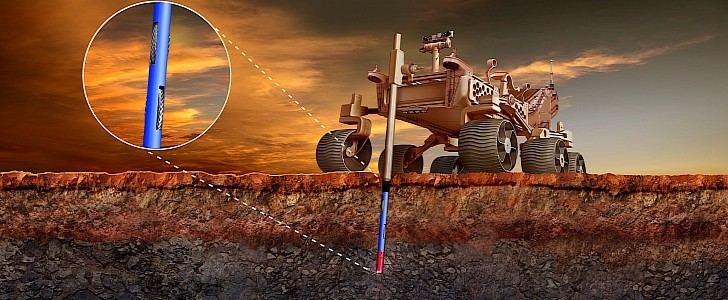Because the entire planet is presently dead, the small fleet of rovers sent to Mars over the years (five of them to date) has always been trying to find out if there is life beneath the surface of the planet. But try as they might, these machines have never been able to dig very deep.
That kind of limits the scope of things we humans can learn about the neighboring planet. Especially considering how a team led by University of Bologna’s Roberto Orosei published a paper in 2018 showing how there might be subglacial liquid water under the planet's permanent polar ice caps. Water that may, if the planets align, still contain life.
The problem is that if it’s there, life-containing water is buried really deep. The deepest current tech is capable of going is just a few inches, which is kind of useless. And this is where these so-called borebots come in.
The concept belongs to Washington-based Planet Enterprises and was included by NASA on the list of projects it backs through the Innovative Advanced Concepts (NIAC) program. It more or less calls for a Perseverance-type rover to be fitted with special hardware that over an extended mission duration could allow for a 1-mile (1.6-km) deep hole to be made in the Martian ice.
The system is called Autonomous Robotic Demonstrator for Deep Drilling (ARD3) and comprises about a dozen robots that would take turns drilling their way down, using the rover as a support platform. They would not use any cables to move up and down, but rely on a rubber track that presses against the sides of the hole, and a robotic arm to position and remove them in and from their worksite.
As per the specs provided, each borebot is 1-meter (3.3-ft) long and should be able to dig itself into the ice and then come out carrying a sample of whatever is down there.
Planet Enterprises proposes a 90-day mission duration to allow a hole up to 50 meters (164 feet) deep to be made and envisions a much longer stay that could allow a depth of nearly 1 mile to be reached.
According to its designers, that could be possible because the “system does not grow in complexity as depth increases." Such a mission should take around four years, during which time thousands of samples could be collected.
For now, the borebots are only at the study level, and as the space agency said for all NIAC projects, they “may never become NASA missions.”
The problem is that if it’s there, life-containing water is buried really deep. The deepest current tech is capable of going is just a few inches, which is kind of useless. And this is where these so-called borebots come in.
The concept belongs to Washington-based Planet Enterprises and was included by NASA on the list of projects it backs through the Innovative Advanced Concepts (NIAC) program. It more or less calls for a Perseverance-type rover to be fitted with special hardware that over an extended mission duration could allow for a 1-mile (1.6-km) deep hole to be made in the Martian ice.
The system is called Autonomous Robotic Demonstrator for Deep Drilling (ARD3) and comprises about a dozen robots that would take turns drilling their way down, using the rover as a support platform. They would not use any cables to move up and down, but rely on a rubber track that presses against the sides of the hole, and a robotic arm to position and remove them in and from their worksite.
As per the specs provided, each borebot is 1-meter (3.3-ft) long and should be able to dig itself into the ice and then come out carrying a sample of whatever is down there.
Planet Enterprises proposes a 90-day mission duration to allow a hole up to 50 meters (164 feet) deep to be made and envisions a much longer stay that could allow a depth of nearly 1 mile to be reached.
According to its designers, that could be possible because the “system does not grow in complexity as depth increases." Such a mission should take around four years, during which time thousands of samples could be collected.
For now, the borebots are only at the study level, and as the space agency said for all NIAC projects, they “may never become NASA missions.”

